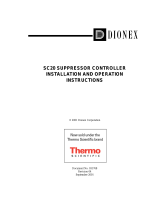Page is loading ...

National Training Department
Panasonic Consumer Marketing
Company Of North America
2012 Plasma TV Troubleshooting Guide
2012-Plasma FHD TV – ST Series (15
th
Generation)
TC-P50ST50
TC-P50UT50
Applies to models:
TTG120313CP120417

Important Information
• To avoid the unnecessary replacement of multiple PC boards, please read this before
beginning to repair this unit.
• Do not use any service documentation other than the one designed for this particular model.
• Techniques used on previous models may not necessarily apply to the model you are
working on.
• For accurate diagnosis during troubleshooting, do not skip or alter the order of steps on the
guide.
Slide 2

When an abnormality occurs in the unit, the “SOS Detect” circuit is triggered and the TV shuts down.
The power LED on the front panel will flash a pattern indicating the circuit that has failed.
Cautions:
If the power LED continues to blink even after the TV is unplugged, press and hold the power switch
on the TV for a few seconds until the LED turns off.
Some steps require removal of connectors and sometimes PC boards removal. Do not allow the TV to
run for more than 30 seconds while connectors or boards are disconnected.
NOTE: When taking voltage reading, place your meter’s probe on the test point or pin indicated before
connecting the TV to the AC line. The voltage you intent to measure may only appear for a brief
moment.
Warning: The Vsus line has large capacitors that hold the charge for some time even after the TV has been turned off and
unplugged. When disconnecting P2/SC2 or P11/SS1, bleed the remaining charge of the Vsus before reconnecting the cable.
Use a 500 ohms/ 5W (At least) resistor to discharge the Vsus line before reconnecting P2/SC2 or P11/SS11.
SOS Precautions
Slide 3

Power LED Error Code Definition (1 of 2)
LIST OF BOARDS POSSIBLY CASUSING THE FAILURE
POWER LED
ERROR
CODE
CIRCUIT MONITORED
CONDITIONS TRIGGERING
THE SHUTDOWN
#1 Suspect #2 # 3 Occasionally
#4
Not Often
1 BLINK
Panel Information SOS
Communication problem A
2 BLINKS P15V form the P board
Missing P15V
P15V is not been generated by the P board.
Wrong diagnostic by the A board
P A
3 BLINKS
Incomplete or interrupted
Boot Program execution of
PEAKS IC (IC8000).
Shorted P15V
Missing F15V
Wrong diagnostic by the A board
A P
4 BLINKS
Power Supply output
voltages
Vsus Over Voltage Condition.
P15V Shorted while in operation.
Wrong diagnostic by the A board
P A
6 BLINKS SC Energy Recovery Circuit
An increase or reduction of the Energy Recovery Circuit
output (MID).
Shorted SUB5V.
Wrong diagnostic by the A board.
SC A C
7 BLINKS
Scan Drive Circuit and
Connection between the SC
board and the SC board.
Missing or shorted Vsus.
Abnormality of the scan circuit output, the 15V_F, the
scn_pro, and Vscn circuit.
Loose or open Connection between the SC board and the
SC board (SC41, SC42, SC46).
Open or loose connection between connectors SC2/P2
Wrong diagnostic by the A board
Defective panel
SU/SD SC SS A/Panel
8 BLINKS
Sustain Drive Circuit and
Connection between the SS
board and the Panel.
Abnormality of the sustain drive circuit.
Open or loose connection between the SS/SS2 Boards.
and FPCs from the panel (SS52 – SS54 – SS55 – SS57).
Open or loose connection between connectors C10/C20 or
C26/C36.
Wrong diagnostic by the A board
SS A C3 Panel
Slide 4

Power LED Error Code Definition (2 of 2)
LIST OF BOARDS POSSIBLY CASUSING THE FAILURE
POWER LED
ERROR
CODE
CIRCUIT MONITORED
CONDITIONS TRIGGERING
THE SHUTDOWN
#1 Suspect #2 # 3 Occasionally
#4
Not Often
9 BLINKS
Discharge Control Circuit
DDC (IC9300)
Failure of IC9300
Wrong diagnostic by the A board
A
10 BLINKS SUB3.3V_Sense (OVP)
Over Voltage Condition of SUB5V or SUB3.3V
Wrong diagnostic by the A board.
A
12 BLINKS Audio Amp. Circuit
Defective Speaker/Subwoofer
Pinched Speaker Wire
Wrong diagnostic by the A board
A
Speakers/
Subwoofer
13 BLINKS
IC8000 Internal
Communication
Defective A board A
Slide 5

IC8000-1
Peaks
LD4
Standby
uCOM
System
uCOM
AD15
PANEL_SOS
9
SC_SOS6
12
8
11
SS_SOS8
SOS_DCC_S (9)
SC_SOS7
10
Normal : all input = “L”
(output = “L” )
SS
A33
5
A20
3
6
SC
IC9300
N2
(Analog output)
6 – 9 blinks
SC_UHZ
18
179
SC
A20
W3
(If no signal,
Discharge Reset
:
6/8 blinks)
1314
T4
AF16
PDP_DRVRST
A31
55
C
3.3V_DET
DRVRST
(If no 3.3V in C1/C2-PCB,
Discharge Reset
:
6/8 blinks)
D_UHZ
7
AG3
SUB3.3V
AD16
FFC_OFF_DET(6)
TC-P**ST50/UT50
(TNPH0989**)
Protection Circuit Block Diagram 1 of 2 (TC-P50ST50)
A32
1
W28
P3.3V
SOS
2 blinks
AE20
Q9201
Q9201
P15V
M28
C24
3 blinks
2 Blinks
if P15 is
missing
3 Fast
Blinks
At plug-in
if SUB3.3
is missing
P15V
Missing 2 Blinks
Shorted 3 Blinks
IC5000
REG
(STB3.3V)
RESET
SUB3.3V
Missing 3 Blinks
At plug-in
Shorted
P15V
Det. Circuit
SUB3.3V
Det. Circuit
N
SOS
Slide 6

Blink Code/Voltage Condition (TC-P50ST50 - TC-P50UT50)
Slide 7
No. of Blinks
Voltage Condition
TC-P50UT50 TC-P50ST50
Missing 2 Blinks 2 Blinks
Shorted
No power. The LED turns on
briefly and then it goes off
immediately
3 Fast Blinks
P15V
Missing 3 Fast Blinks at Plug-in 3 Fast Blinks at Plug-in
Shorted 3 Fast Blinks at Plug-in 3 Fast Blinks at Plug-in
SUB3.3V
Over Voltage
Dead. Power LED never
turns on
10 Blinks
Missing 3 Fast Blinks at Plug-in 3 Fast Blinks at Plug-in
Shorted 6 Blinks After 11sec. 6 Blinks After 11sec.
SUB5V
Over Voltage
Dead. Power LED never
turns on
10 Blinks

IC8000-2
Peaks
LD4
Standby
uCOM
System
uCOM
STB3.3V
SOS
10 blinks
AA15
Q8771
Q8771
SUB3.3V
FAN_SOS
H6
ALL_OFF(P_SOS4)
A6
4
P
AE15
4 blinks
SUB5V
TC-P**ST50/UT50
(TNPH0989**)
SUB3.3V
SOUND_SOS
12blinks
IC4900
Audio
AMP
22
AD19
IC4901
Audio
AMP
22
Normal=“H”
(11blinks)
Emergency : 13 blinks
IROM error : quickly 3 blinks
SUB5V &
SUB3.3V
OV Det.
Circuit
10 Blinks if
SUB5V or
SUB3.3V is
too high
SUB5V
Missing 3 Fast
blinks at
plug-in
Shorted 6 blinks
after 11 sec.
Over Voltage 10 blinks
Protection Circuit Block Diagram 2 of 2 (TC-P50ST50)
Slide 8

Troubleshooting 1 -9 -10 - 13 Blinks Failure
When 1, 9, 10, or 13 blinks occur, replace the A board
Blink
Code
List of boards likely to cause this symptom
No.1 No.2 No.3 No.4
1 A Board
9 Blinks A Board
10 Blinks A Board
13 Blinks A Board
Slide 9

Troubleshooting 2 Blinks Failure (TC-P50ST50)
Yes
Place the positive lead of a voltmeter at pin 13
of connector P6 while the black lead is
connected to ground (Chassis ground). Plug in
the TV and turn it on
No
Does 15V
appears
momentarily
on pin13 of
CN P6?
Start Here
Replace the A
board
Replace the P
board
List of boards likely to cause this
symptom.
Blink
Code
No.1 No.2 No.3 No.4
2 Blinks P A
Slide 10
Find information for TC-
P50UT50 on the next slide)

Troubleshooting 2 Blinks Failure (TC-P50UT50)
Yes
Place the positive lead of a voltmeter at
pin 13 of connector P6 while the black lead
is connected to ground (Chassis ground).
Plug in the TV and turn it on
No
Does 15V appears
momentarily on
pin13 of CN P6?
Start Here
Replace the P
board
List of boards likely to cause this
symptom.
Blink
Code
No.1 No.2 No.3 No.4
2 Blinks P A Panel/C2
Slide 11
Unplug the TV. Check the resistance between TP201 (P3.3V)
on the C2 board and chassis ground.
Replace the A
board
Yes No
Is there a
short
circuit?
Defective
Panel and/or
C2 board
Find information for TC-
P50ST50 on the previous
slide)

Troubleshooting 3 Fast Blinks Failure (TC-P50ST50)
Yes
Unplug the TV. Check for short circuit or low
resistance between pin 13 of connector P6
and ground (Chassis ground).
No
Is there a short
circuit or a
resistance
lower than 1
Kilo-ohm?
Start Here
Replace the P
board
Replace the A
board
List of boards likely to cause this symptom. Blink
Code
No.1 No.2 No.3 No.4 No.5
3 Blinks A P SS/SC
Bluetooth
Module
Panel
Is there a short circuit
or a resistance lower
than 1 Kilo-ohm?
Yes
No
Replace the A
board
With the TV still disconnected, remove connector
A6 from the A board and perform the same
resistance check on pin 13 of connector P6.
Reconnect A6 and remove connector SC20
from the SC board and check for short circuit
or low resistance on pin 13 of connector P6.
Is there a
short circuit or
a resistance
lower than 1
Kilo-ohm?
Yes
No
Replace the SC
board
Reconnect SC20 and remove
connector SS33 from the SS board
and check for short circuit or low
resistance on pin 13 of connector P6.
Is there a short
circuit or a
resistance lower
than 1 Kilo-ohm?
Yes
No
Replace the SS
board
Slide 12
Unplug the blue-
tooth module. If the
blinking stops,
change the blue-
tooth module
Reconnect SS33 and remove connector
A31 and A32 from the A board and
check for short circuit or low resistance
on pin 13 of connector P6.
Is there a
short circuit or
a resistance
lower than 1
Kilo-ohm?
Yes
No
If no short
circuit is found
on any of the C
boards, change
the panel

Troubleshooting 3 Fast Blinks Failure At Plug-in (TC-P50UT50)
Yes
Unplug the TV. Connect the negative (Black
lead) of your DC volt- meter on chassis
ground. Place the positive lead of on pin 10 of
connector P6 on the power supply. While
observing the display on your meter, plug-in
the TV.
No
Does 15V
appear briefly?
Start Here
Replace the K
board
Replace the P
board
List of boards likely to cause this symptom. Blink
Code
No.1 No.2 No.3 No.4 No.5
3 Blinks A P K
Bluetooth
Module
C3/Panel
Does the TV turn
on and stays on?
NoYes
Unplug the TV and remove connector K1 from the A board.
Plug in the TV and press the power switch on the TV.
Unplug the TV and reconnect K1. Disconnect
connectors A31 and A32 from the A board.
Plug-in the TV.
Is the power
LED blinking
3 or 8 times?
Replace the A
board
Slide 13
Unplug the blue-
tooth module. If the
blinking stops,
change the blue-
tooth module
3 times
8 Times
Defective Panel or/and the C3 board.
To time it takes to isolate the C3 board from the
panel is approx. 30 minutes.
To isolate the C3 board, reconnect A31 and A32
and remove the metal bracket over the C
boards. Disconnect connectors CB12~CB15
from the C3 board and plug-in the TV. If the
power LED stops blinking at plug-in, then the
Panel is defective. If the LED blinks 3 times,
then the C3 board is defective.

Troubleshooting 3 Fast Blinks Failure At Power-On (TC-P50UT50)
1. Unplug the TV.
2. Remove any residual charge from the Vsus and Vda lines. Use a 5W 500ohms resistor.
3. Measure the resistance between chassis ground and pin 1 of connector P11 on the P board. Also measure the
resistance between chassis ground and pin 1 of connector P35 on the P board. (See the picture below for
connectors’ location.) Note: A dead short or a reading lower than 1K indicates a shorted or partially shorted line.
Slide 14
Is there a short
circuit of the
Vsus or Vda,?
Yes
No
Start Here
Replace the A
board
Shorted
Vda
Shorted
Vsus
Continue on
next slide (A)
Continue on
next slide (B)
POWER SUPPLY
( 1 of 2)

Shorted
Vda
Shorted
Vsus
Unplug connectors P2 and P11, on the P
board. Measure the resistance between pin
1 of connector P11 and ground (Chassis)
With P2 and P11 disconnected,
measure the resistance between
pin1 of connector SC2 on the SC
board and ground (Chassis).
No
Yes
Is there a
short
circuit?
Replace the P
board
Yes
No
Is there a
short
circuit?
With P2 and P11 disconnected,
measure the resistance between
pin1 of connector SS11 on the
SS board and ground (Chassis).
Yes
No
Is there a
short
circuit?
Replace the
SC board
Replace the
SS and the
SC boards
Replace the
SS
Slide 15
From previous
slide (A)
From previous
slide (B)
( 2 of 2)
Yes
No
Replace the P
board
Is there a
short
circuit ?
Unplug the TV and remove
connector P35. Check the
resistance between pin 1 of
connector P35 on the P
board and ground (Chassis).
Replace the Panel (Check
the C boards first for
shorted Vda).

Troubleshooting 4 Blinks Failure
List of boards likely to cause this
symptom.
Blink
Code
No.1 No.2 No.3 No.4
4 Blinks P A
Yes
Place the positive lead of a voltmeter at pin 4 of connector P6 while the black lead is connected to
ground (Chassis ground). Plug in the TV and turn it on
No
Is there 2V to 3V
(Approx.) momentarily
on pin 4 of CN P6?
Start Here
Replace the A
board
Replace the P
board
Slide 16

Troubleshooting 6 Blinks Failure
List of boards likely to cause this
symptom.
Blink
Code
No.1 No.2 No.3 No.4
6 Blinks SC A
Yes
Verify that all the cables on the SC board are properly seated. Also check the ribbon cables and connectors on the A
and C boards. Unplug the TV and disconnect connector SC20 on the SC board. Plug in the TV and turn it on
No
Did the
number of
blinks change
to 8 blinks?
Start Here
Replace the A
board
Replace the SC
board
6 Blinks
Slide 17

Troubleshooting 7 Blinks (SOS 7)
A 7 blinks shutdown can be caused by a failure of any or a combination of the following boards:
SU/SD, SC, A, or the Panel. Is also possible for the SS board to cause 7 blinks shutdown on this model.
Note: This page indicates the order in which these boards are likely to fail. This information alone is not
enough to diagnose which board is defective. To determine the cause of a 7 blinks failure, follow the
troubleshooting procedure on the following pages.
Most Likely.
“SU or SD”
2
nd
most
common.
“SC”
Possibly,
but not
common
“A”
1 2 3
Order of Failure
SS
Slide 18

Troubleshooting 7 Blinks Failure (TC-P50ST50)
Is the power
LED blinking 7
or 8 times?
8 Times
7 Times
Check the wires between connector P2 on the P board and
SC2 on the SC board. Make sure they are properly seated. If
the problem persists, unplug the TV and remove connector
SS11 from the SS board. Plug-in the TV and turn it on.
Start Here
List of boards likely to cause this symptom. Blink
Code
No.1 No.2 No.3 No.4 No. 5 No. 6
SU SC SS A Panel 7
Blinks
SD
Is the power
LED blinking 7
or 8 times?
7 Times
8 Times
Unplug the TV and reconnect SS11.
Remove SC20 from the SC board.
Plug-in the TV and turn it on.
Unplug the TV. Reconnect SC20
and follow step #1 of the next slide.
Replace the SS
board
Replace the A
board
Continue on the page after next
Slide 19
Find information for TC-P50UT50 on slides 23~26

Troubleshooting 7 Blinks Failure (F5V/TPSC Resistance Check)
Disconnect the AC prior to making any disconnection or connection. Wait at least 2 minutes before the removal of any connector.
From before the previous page
Unplug SU41 and SD42. Using any of the
VFG Screws (Floating ground screws) as
ground, measure the resistance of pin 2 and
pin 6 of bothSU41 and SD42.
Using any of the VFG screws (Floating ground screws)
as ground, measure the resistance of pin 2 and pin 6 of
either SU41/SC41or SD42/SC42.
If a short circuit is found, proceed with step 2.
If no short circuit is found, isolate the SU and SD boards
as illustrated on the next slide.
1 2
Continue on the next page
Step Step
A short circuit indicates the failure of the
board where it was found.
Note: Change the SU and SD boars together
even if only one is found to be defective.
Slide 20
/


